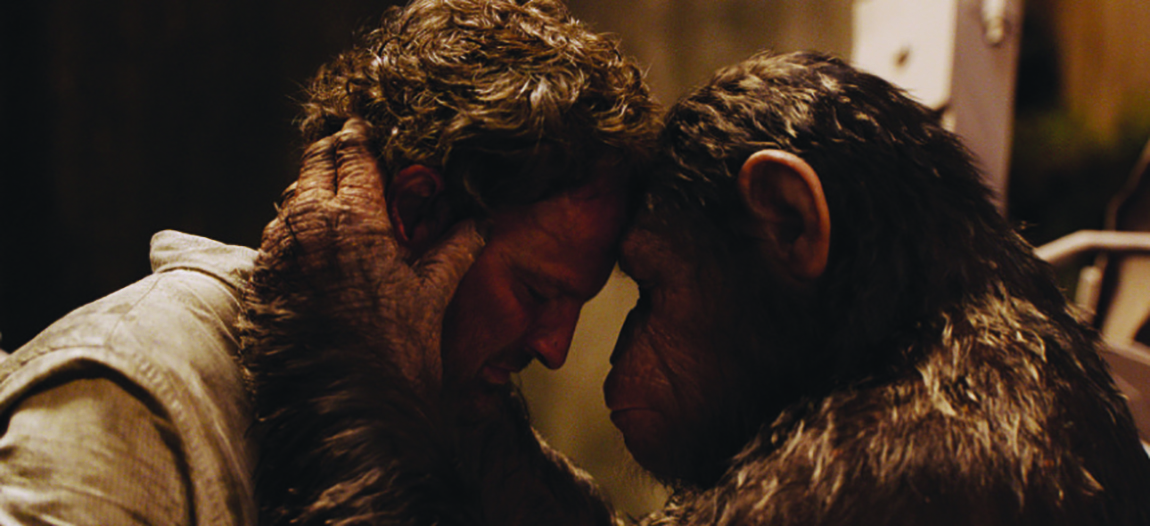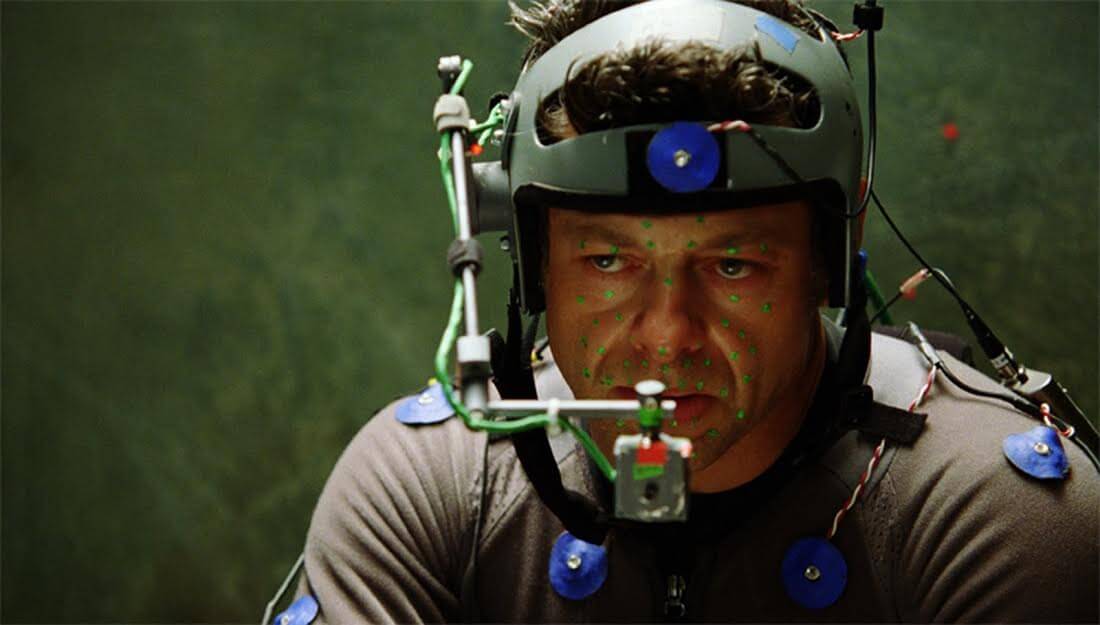

How Ben Kilgore, Computer Animation and Interactive Media ’04, builds life-like computer-generated imagery for Hollywood blockbusters
by Jonathan Vatner
In the first few minutes of the 2014 hit Dawn of the Planet of the Apes, not one human appears. A pack of majestic apes hunt deer through a lush rain-forest, dense with trees that seem to reach upward forever. Their faces are expressive, their hair ripples in the gentlest breeze, and their muscles tense and relax beneath their skin. When a trigger-happy Homo sapiens finally barges in, it’s hard not to side with the apes—which is a testament to the skill and discipline of Ben Kilgore, Computer Animation and Interactive Media ’04, and his colleagues at Weta Digital, a visual-effects firm based in Wellington, New Zealand. Because, as most everyone knows, these are not animals or even people in animal costumes. They are glorious tangles of ones and zeroes—computer code translated into creatures that couldn’t seem more real.
As a lead creature technical director at Weta, Kilgore is in charge of creating computer-generated beasts for Hollywood films. He gave life to a menagerie of creatures in The Hobbit films, Mr. Fantastic’s rubber limbs in Fantastic Four (2015), and the apes in the recent Planet of the Apes reboots.
Weta, founded by director Peter Jackson and named after a large biting bug endemic to New Zealand, is known for its skill at performance capture: an actor plays an animal, monster, or robot, wearing a bodysuit embedded with motion sensors, as well as face sensors to record every twitch. This animation data—both spatial and facial—is then used to build creatures that appear to move and emote naturally.
Performance capture—as opposed to traditional keyframe character animation—became widely known when Andy Serkis played Gollum in The Lord of the Rings trilogy, films that Weta Digital worked on. Serkis also played Caesar the ape in the recent Planet of the Apes films—and was given top billing in the credits.
“It isn’t a terribly new technology,” Kilgore explains, “but we push it further than ever before. When you see Caesar emoting, you’re actually seeing Andy emoting.”
Weta has developed proprietary software called Tissue that realistically simulates animal muscle tension and movement; the firm won an Academy Award for Technical Achievement for the software in 2013. Weta technicians use it to layer on bones, muscles, fat, skin, and fur, creating animals that breathe and lope and leap as if they were alive.
The process requires not just exhaustive naturalistic precision but also artistic judgment. For example, the apes look like chimps, gorillas, and orangutans, but they are actually humanoid versions of those species. The creatures team had to decide exactly how they might stand and hold their shoulders, down to what their necks might look like when they press their chins forward. “We’re reproducing anatomy that doesn’t exist,” Kilgore says. “We use a combination of art and technology to make it look real.”


To help collect animation data for Caesar, the ape-in-chief in Dawn of the Planet of the Apes, Andy Serkis donned a motion-capture suit and helmet and acted out the scenes opposite the human characters. Kilgore and his team translated Serkis’s movements and expressions into Caesar’s affecting performance. Photos: © 20th Century Fox Film Corp. All rights reserved. Courtesy of Everett Collection.
Animals have thousands of hair follicles per square inch. Each one needs to be “grown,” but Kilgore uses a repeating code that speeds up the process. In this way, his job is part illustrator, part computer scientist. Before he can see how it looks, it must “bake” overnight in Weta’s servers. In the morning, he can watch it in high resolution.
The tissue software takes into account the laws of physics—the density and stiffness of objects that hit the animal, as well as the effects of gravity—but the “creature bakes” implode when animals bump into each other, or when the designers need to create movements that aren’t naturally possible, such as when Reed Richards’s arm stretches 20 feet in Fantastic Four. “It turns into a polygon explosion,” Kilgore says.
Even when the technical directors pull off a beautiful shot, the process is far from done. More often than not, the film’s director asks for revisions. Taking into account every step of the visual-effects process, a single shot from Fantastic Four went through about 500 iterations.
When the director signs off on Weta’s work, another team lights the creatures to match the scene, and a separate group composites them into the action. After months of round-the-clock work by Weta specialists, not to mention the years of script revisions and storyboards and shoots, moviegoers consume the film in about two hours.
Kilgore was 13 when Terminator 2 hit theaters, and the T-1000 robot, a villain that seemed to be made of liquid metal, thrilled him. “I had to know how they did it,” he says. But he bounced around various jobs—landscaper, tattoo artist, construction worker, plumber—until he enrolled at FIT in 2003. “I don’t think I’ve worked as hard as consistently on any project as I did at FIT,” Kilgore recalls. “I’d sleep there, eat there, and shower at the gym.”
Adjunct Assistant Professor Silvia Feriozzi, the department’s thesis advisor, was impressed by his skill, determination, and sensitivity: “He was able to create the quality of work that we more often see in professional production companies than in the classroom setting.”

After graduation, he started in the film industry as a creature rigger at Blue Sky Studios, known for the Ice Age films. A rigger creates versatile digital puppets that can be manipulated by animators; it’s part of what he does now for live-action films. For Kilgore, Ice Age: The Meltdown (2006) was a trial by fire. He had to learn to use Blue Sky’s software suite and write code. “It was my big break, and I couldn’t blow it,” he says. “It was very, very stressful.”
From there, he worked for a number of small visual-effects studios in New York and Los Angeles before moving to New Zealand in 2010 to join Weta Digital. When he arrived, the company was almost finished with Steven Spielberg’s The Adventures of Tintin (2011), a wholly computer-generated feature. Kilgore was assigned to create various animals.
“I worked on a jiggly cow, with all these jiggly cow bits hanging off of it.” As it turned out, Spielberg thought his cow was funny. “That was the highlight of my week!” Kilgore says.
He created a gooey, menacing alien for Prometheus (2012), a herd of horses for Abraham Lincoln: Vampire Hunter (2012), and Rondor beasts (“kind of like space cows”) for Man of Steel (2013).
He also fine-tuned the apes’ muscle movements in Rise of the Planet of the Apes (2011). But Dawn of the Planet of the Apes was a huge step forward, both for his career and for Weta. Between the two films, Weta designers had rebuilt all the creature models. The hair contained more, higher-resolution filaments, and it looked muddy and wet when it rained in the film. The apes’ movements were more natural, too.
Weta is doing the most cutting-edge computer animation work in the industry, and for that reason, Kilgore doesn’t plan on leaving New Zealand anytime soon. “The kind of work that comes to Weta,” he says, “doesn’t exist anywhere else in the world.”
Check out this selection of visual effects Ben Kilgore has worked on here.
Featured photo TM and © 2013 Twentieth Century Fox Film Corporation. All rights reserved.